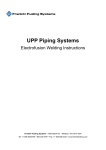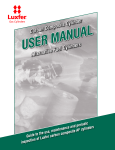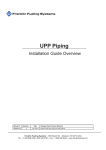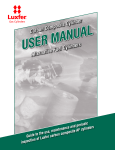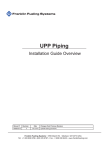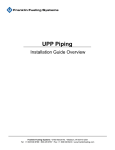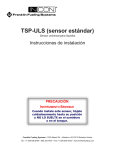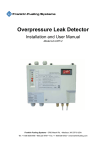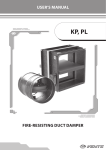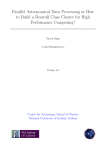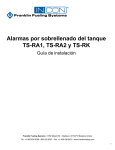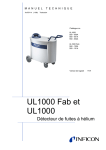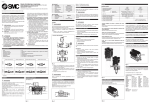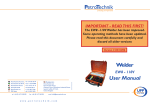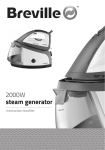Download User Manual - Franklin Fueling Systems
Transcript
UPP System Integrity Testing Kit Model VTU2 User Manual Franklin Fueling Systems • 3760 Marsh Rd. • Madison, WI 53718 USA Tel: +1 608 838 8786 • 800 225 9787 • Fax: +1 608 838 6433 • www.franklinfueling.com 1. Introduction The UPP System integrity testing kit allows for precise testing of the tightness of single wall underground tank chambers (sumps) and dispenser sumps. The versatile unit can also be used to test double wall dispenser and tank chambers and also the interstitial space in secondary contained (double wall) pipe systems. 2. Safety Instructions • The system integrity testing unit is designed specifically for use on fuelling installations and should be protected against water and dust. • The machine should be handled with the care usually given to sensitive electrical equipment, especially during transport. • Each time the machine is used, the condition of the machine, and especially the power cable needs to be checked. If damage is discovered, the machine needs to be returned directly to the supplier or an authorised service centre. • Before connecting the machine, the power source needs to be checked with regard to the rating of the test unit (230v or 110v - see specifications). •Never pull and/or lift the machine by its power cable. • The machine should only be operated outside of zone 2 areas (hose length permits testing inside these areas even when the machine is situated outside) IMPORTANT: Ensure that any storage tank is completely sealed and isolated from the chamber whilst it is being tested. Tanks are not designed to withstand a vacuum and damage may result. 3. Liability restrictions In each of the following cases, all liabilities of the supplier are invalidated if: • • • • • 2 The machine is used outside the indicated application area The operator is not trained to use this machine The recommended maintenance intervals are not observed The safety instructions are not observed Repairs have been performed by other than the supplier or their authorised agent 4. Operating Instructions The VTU2 is designed to automatically condition and test in one sequence of operations. Conditioning is an essential step, when tightness testing Polyethylene systems due to the flexible nature of the material, to ensure that no false results are obtained. This is achieved by pulling a vacuum a total of three times, resting and allowing the assembly to contract for 60 seconds after the first and second evacuations and commencing the test proper after the third. Figure 1: VTU2 Front Panel To aid any necessary leak detection and remedial work, it is recommended that UPP tank chambers are tested in specific stages during the installation process. Test 1 - Testing the base of a two-piece tank chamber After installing the tank chamber base, test for tightness as follows: 1. Make sure the vacuum lid gaskets and chamber base flange are clean and free from dirt and debris. 2. Place the vacuum lid on to the chamber base. 3. Place the test unit outside zone 2 (if on a live site) but as close to the chamber as possible and within 4 meters of an electrical power source. 4. Connect the hoses between the lid and the test unit, check that hose ends are in good condition. 5. Make sure the test on / off switch is set to “0” position and connect the power lead from the test unit to the power supply. 6. Select “Chamber / Sump” setting. 3 7. Set switch to Test On position and unit will go through calibration process with coloured lights flashing. 8. When calibration is complete vacuum pump will run until the correct test vacuum is reached, unit will commence conditioning and test sequence. Test will commence after third pump run and blue test light will be on. 9. When vacuum has been held for the required test period, the green light will illuminate and the chamber can be considered leak-tight. 10. If the vacuum is not held then the red light will illuminate and the chamber should be investigated using a leak detection liquid spray. The only possible leak point should be the tank sump / chamber mounting flange. Once the chamber base is leak tight, install pipe-work and proceed to test 2. Test 2 - Testing the base of a two-piece tank chamber (2) After installing the seals and pipe runs, re-test the base for tightness. To test the chamber base, follow these instructions: 1. Make sure the vacuum lid gaskets and chamber base flange are clean and free from dirt and debris. 2. Place the vacuum lid on to the chamber base. 3. Place the test unit outside zone 2 (if on a live site) but as close to the chamber as possible and within 4 meters of an electrical power source. 4. Connect the hoses between the lid and the test unit, check that hose ends are in good condition. 5. Make sure the test on / off switch is set to “0” position and connect the power lead from the test unit to the power supply. 6. Select “Chamber / Sump” setting. 7. Set switch to Test On position and unit will go through calibration process with coloured lights flashing. 8. When calibration is complete, the vacuum pump will run until the correct test vacuum is reached. The unit will then start the conditioning and test sequence. Test will commence after third pump run. The blue test light will be on. 9. When vacuum has been held for the required test period, the green light will illuminate and the chamber can be considered leak-tight. 10. If the vacuum is not held then the red light will illuminate and the chamber should be investigated using a leak detection liquid spray. 4 Possible leak points are: • Pipe / seal interface • Electrofusion / chamber interface • Vacuum lid seal • Conduit seals • Vacuum pipe connections Test 3 - Testing the chamber riser 1. Uncouple the hose connection from the vacuum lid and remove the vacuum lid from the base section. Join the riser to the base section as detailed in the relevant chamber installation instructions (FFS document FFS-0129. On the web http://www.franklinfueling. com/service. Select Service / Technical Documentation / Piping and Containment). 2. Place appropriate test-lid on riser. 3. Connect vacuum hoses to riser lid. 4. Select Chamber / Sump test setting. 5. Re-run test as in test 1. 6. If the vacuum is not held, investigate the chamber using a leakdetection liquid spray. Possible leak points include: • • • • Centre section seal Vacuum lid seal Riser seals Vacuum pipe connections Never set switch to “pressure test only” without prior Caution consultation with Franklin Fueling Systems. Serious damage to the machine or chamber could result. Never enter a chamber or sump whilst it is under vacuum test as serious injury could result. 5 5. Vacuum Test Parameters Setting Vacuum Time Chamber / Sump -30 mbar 7 minutes Spill Bucket -30 mbar 1.5 minutes 6. Fault Diagnosis 6 Fault Solution Vacuum level not reached or keeps on falling • Check and listen for leaks in all the areas outlined in the tests. Rectify faults if found Vacuum still falling. All areas on chamber are leak tight • Check containment collar flange and fittings for leak path. Contact tank manufacturer if leak is found for alternative sealing solutions. • Possible leak inside unit, contact FFS customer support for full diagnostic Vacuum equipment running but no vacuum being produced • Check connection to vacuum lid and pump. To check pump, block one end of pipe and monitor the movement of the vacuum gauge. • Possible leak inside unit, contact FFS customer support for full diagnostic Pump not running • Check power to unit and electrical fuse 7. Specifications 110v model 230v model VTU2-110V VTU2-230V Voltage 100-110V 230V ± 10% Frequency 50/60Hz 50/60Hz 145 W / 2.9A 145 W / 1.54A Model designation Power rating Enclosure protection class IP54 Operating temperature limits 0-50º C (32 - 122º F) Fuse protection Dimensions 5A anti-surge 420 mm x 250 mm x 280 mm (16.5" x 9.8" x 11") Weight 17.5 kg (38.6 lb.) 8. Accessories Test Lids Description Chamber Test Lid Assy Sump Test Lid Assy Size mm Model Designation 560 dia VTL-560 DIA 1200 dia VTL-1200 DIA 1350 dia VTL-1350 DIA 800 x 800 VTL-800x800 1250 x 600 VTL-1250X600 1470 x 600 VTL-1470X600 All test lids supplied in a hard-wearing carry bag 7 Warranty Statement The Franklin Fueling System Integrity Testing Kit is designed for use with Franklin Fueling’s UPP product range. This unit should always be used within the constraints and capabilities of the equipment being tested. If you have any doubts as to the required settings for UPP Systems please consult Franklin Fueling Systems at the address shown. Should you wish to use this Integrity Testing Kit on other manufacturer’s equipment, it is the responsibility of the user to check the capabilities of the parts being tested prior to use of this equipment. No liability will be accepted by Franklin Fueling Systems or its distributors / agents for damage caused during tests carried out on other manufacturers equipment. It is the responsibility of the user to seek a disclaimer and indemnify against damage caused by the use of this testing kit on other manufacturers equipment. Franklin Fueling Systems LTD 8 Olympus Close • Whitehouse Industrial Estate Ipswich, Suffolk IP1 5LN • United Kingdom Tel: +44 1473 243300 • Fax: +44 1473 243301 © 2012 FFS 408047001 Rev 1








